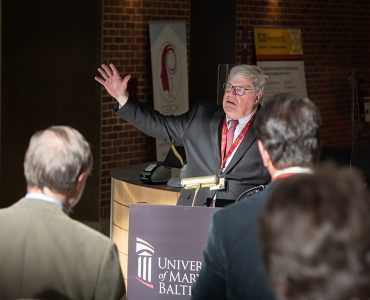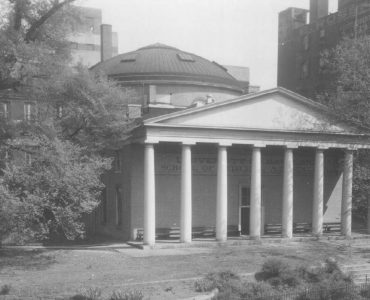When the University of Maryland School of Medicine (UMSOM) was founded as the College of Medicine of Maryland in 1807, it was the fifth medical school in the country. But clinical instruction in medical education was rare, and no U.S. medical schools owned or operated hospitals.
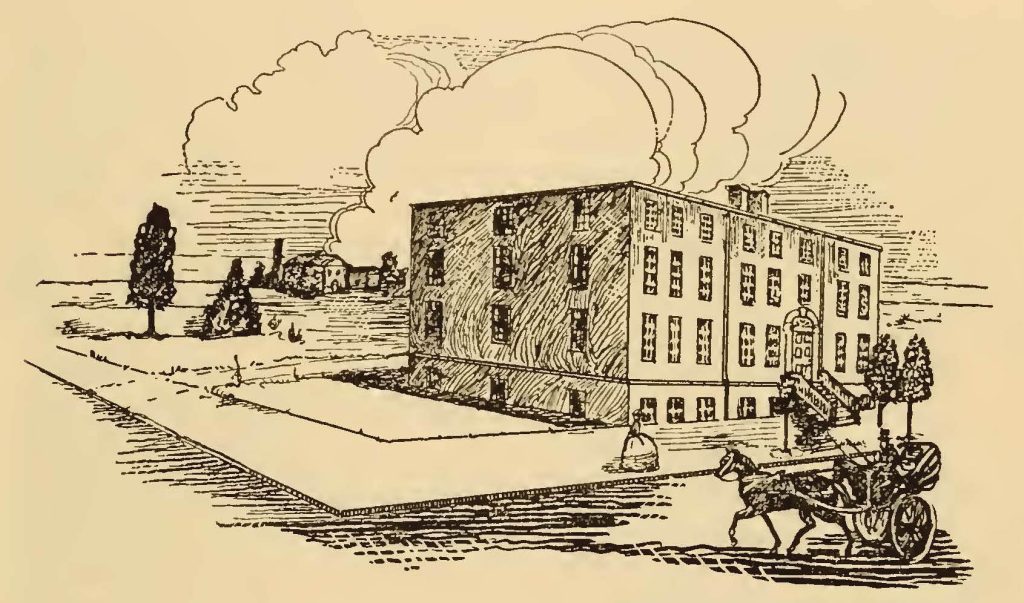
Drs. James Cocke and John B. Davidge, UMSOM faculty members and founders, recognized the importance of bedside medical training and found the institutions nearest to the University unsatisfactory and inconvenient for their clinical instruction needs. In 1823, they persuaded their colleagues, Drs. Nathaniel Potter, Richard Hall, Elisha DeButts, Samuel Baker, Maxwell McDowell, and Granville S. Pattison, to use personal funds and loans to finance a hospital for clinical education at UMSOM. The resulting Baltimore Infirmary — the precursor of today’s University of Maryland Medical Center (UMMC) — became the first hospital built by a medical school in the United States.
In July 1823, the men leased land on the southwest corner of Lombard and Greene streets — where today’s Health Sciences and Human Services Library, SMC Campus Center, and University of Maryland School of Nursing stand. The original infirmary building cost $14,109 — which would be over $335,000 today — to construct and furnish. The Baltimore Infirmary held 60 beds when it opened in September 1823.
According to a 1939 article by Arthur Lomas in the UMSOM Bulletin, one witness said of the new infirmary, “Its facility of access, being separated from the college building by only the width of the street, and its absolute control by the Faculty, at once gave the institution advantages possessed by no other school in that day.”
On Oct. 27, the first clinical lectures were held. Students were expected to attend two surgical and two medical clinics each week, the cost of which was $5 per year. Students also were encouraged to attend physicians’ and surgeons’ daily rounds. Professor William Power’s Theory and Practice course description in the 1850 academic catalog described clinical instruction as learning the “art as well as the science of medicine.” UMSOM students were presented with opportunities to study disease, trauma, and illnesses not available at other medical institutions.
“A great advantage of this institution is that it possesses a hospital of its own, open at all times to its students, where the truths taught in the lecture room may be demonstrated to the senses, and submitted to the observation of its pupils. It is only at the bedside that accurate diagnosis can be taught, and the shifting indications for the use of therapeutical means nicely discriminated,” according to the 1848 UMSOM annual catalog.
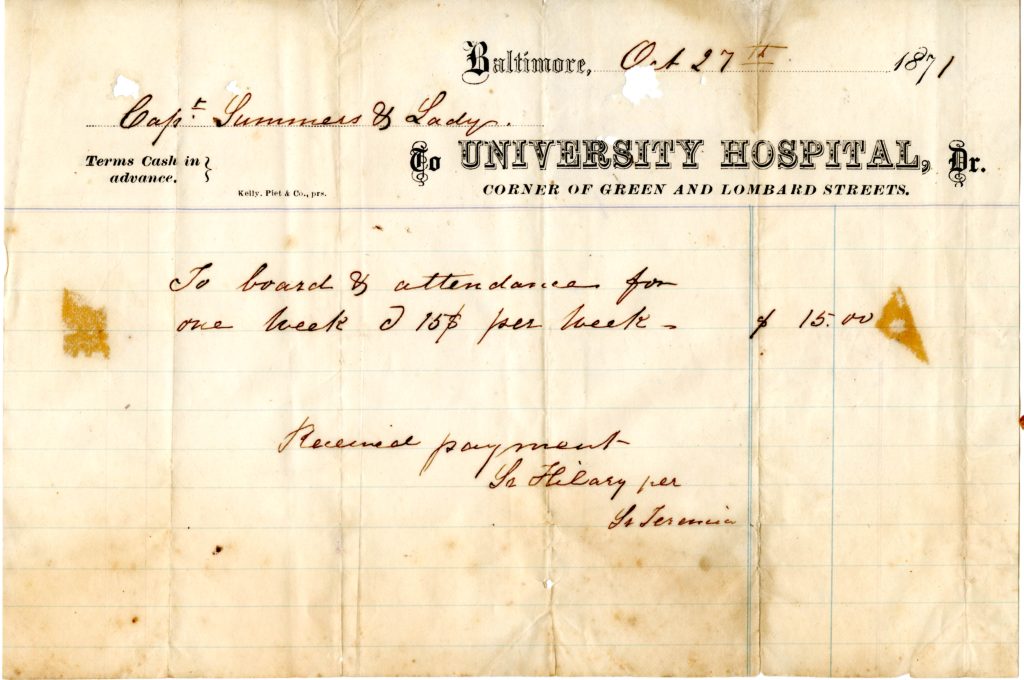
In addition to the UMSOM faculty, the infirmary was staffed by two students, chosen to be resident physicians, as well as sisters from Mount St. Mary’s. The students lived in the infirmary, paying $300 board and lodging. The Sisters of Charity nurses served from November 1823 until 1876. As part of the agreement with Mount St. Mary’s, the Bible was read daily in each of the four wards. The cost for patients was $3 per week, or $87.72 today.
A Maryland legislative act passed three years after the infirmary opened placed ownership of the University in the hands of the state. When the governor subsequently became president of the University and infirmary, the faculty was dismissed, with any professor wishing to continue teaching needing to reapply. The faculty received no pay for their work in the infirmary but remained responsible for all existing personal loans taken out to pay for the construction and furnishings of the infirmary. This arrangement lasted until April 1839, when the Maryland Court of Appeals declared the 1826 act unconstitutional and power over the University and hospital was returned to the University’s Board of Regents.
An addition in 1852 that increased the number of beds from 60 to 150 made it the largest hospital in Baltimore. The work included adding a clinical amphitheater for teaching purposes, supporting the 1848 UMSOM decision to require that students attend at least two sessions of instruction in the infirmary before graduation. The expansion was funded with the earnings from a $5,000 donation from Baltimore merchant George Gray.
A $30,000 appropriation from the state in 1875 funded a new wing on the Greene Street side of the building. The addition created space for a new lying-in (today’s maternity ward) department, a department for diseases of children, and an Eye and Ear Dispensary started by Dr. J.J. Chisolm. The addition also created space for 24 resident students to live. The cost of a week’s stay in the infirmary was $15 per week, or $377.49 today.
UMSOM faculty together with Louisa Parsons, superintendent, founded the University Hospital Training School for Nurses in 1889. The new school professionalized the infirmary’s nursing staff. By 1892, the training school held its first commencement, graduating eight nurses. The training school was a precursor of today’s School of Nursing.
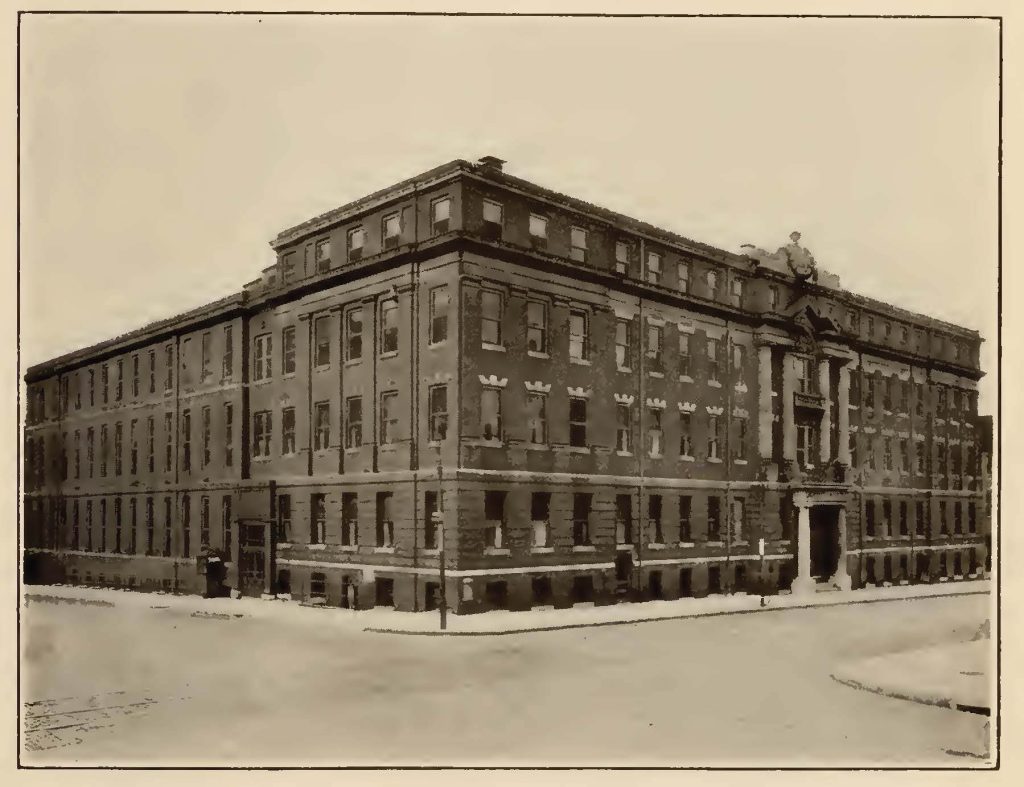
In 1897, a five-story, 190-bed hospital opened at a cost of $90,000 — over $3.3 million today. The building bore the name “University Hospital,” which had been casually used when referring to the Baltimore Infirmary since the 1870s. The 1897 hospital operated until 1934, when the hospital moved to Greene and Redwood streets — the current site of UMMC.
“During the 109 years of the existence of the Baltimore Infirmary and the University Hospital, it has faithfully served the citizens of this city and state and those of many other states as well, and its doors have never been closed. Its physicians and especially its surgeons have not only served without pecuniary compensation but have ever been ready to answer the call of service, by day and by night,” Dr. Randolph Winslow, chief surgeon and UMSOM professor, said a year before the new building opened.


